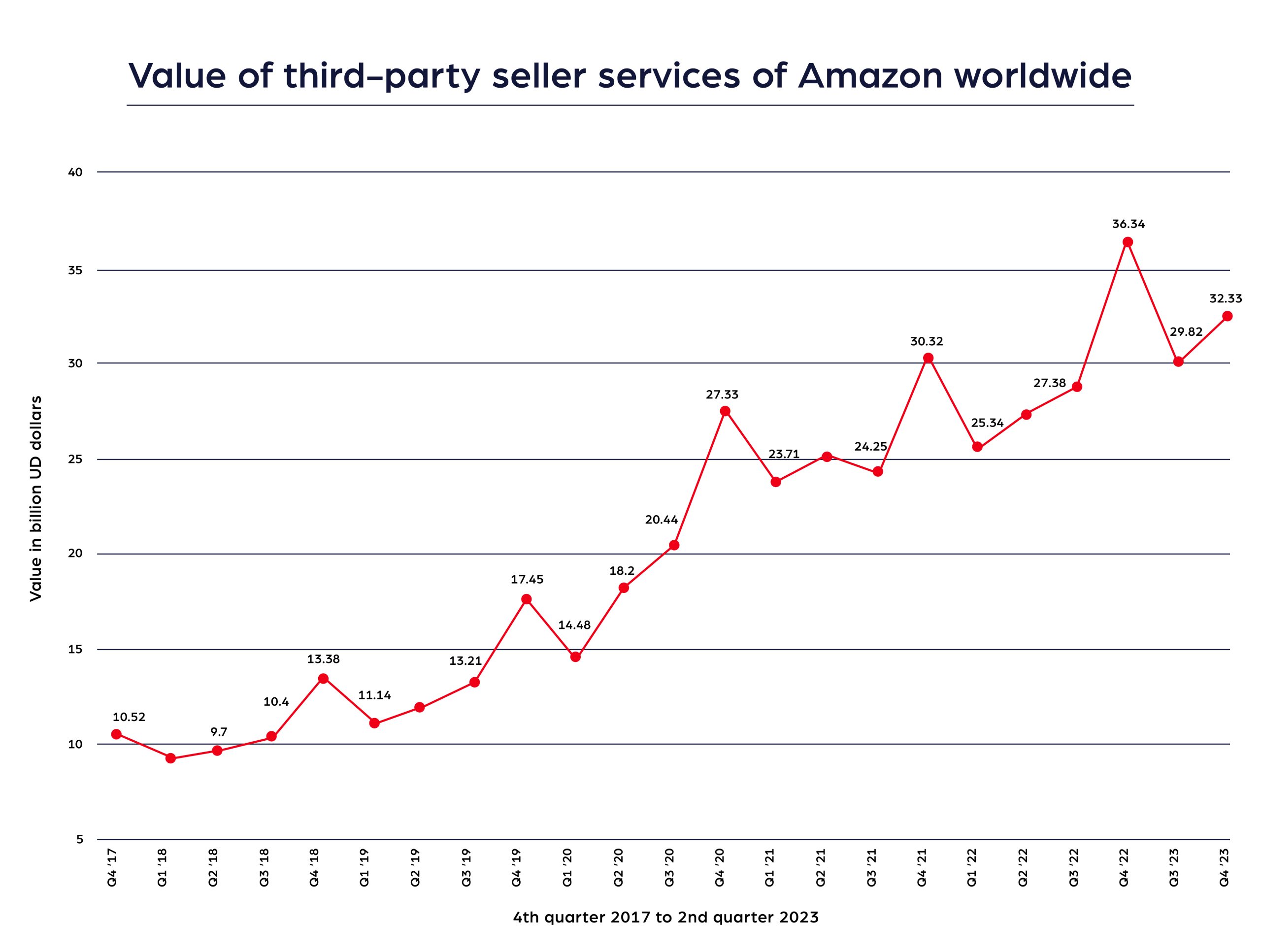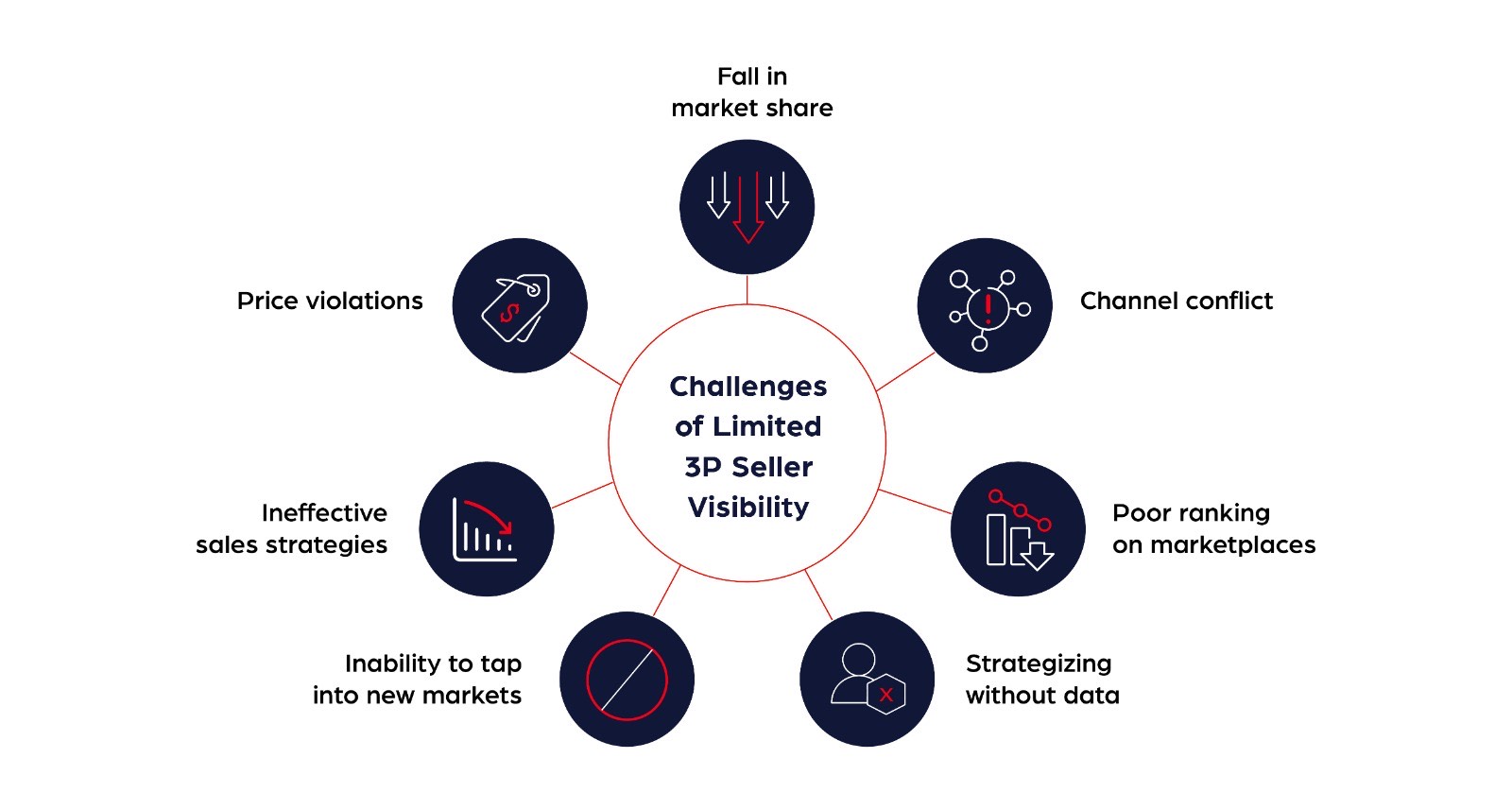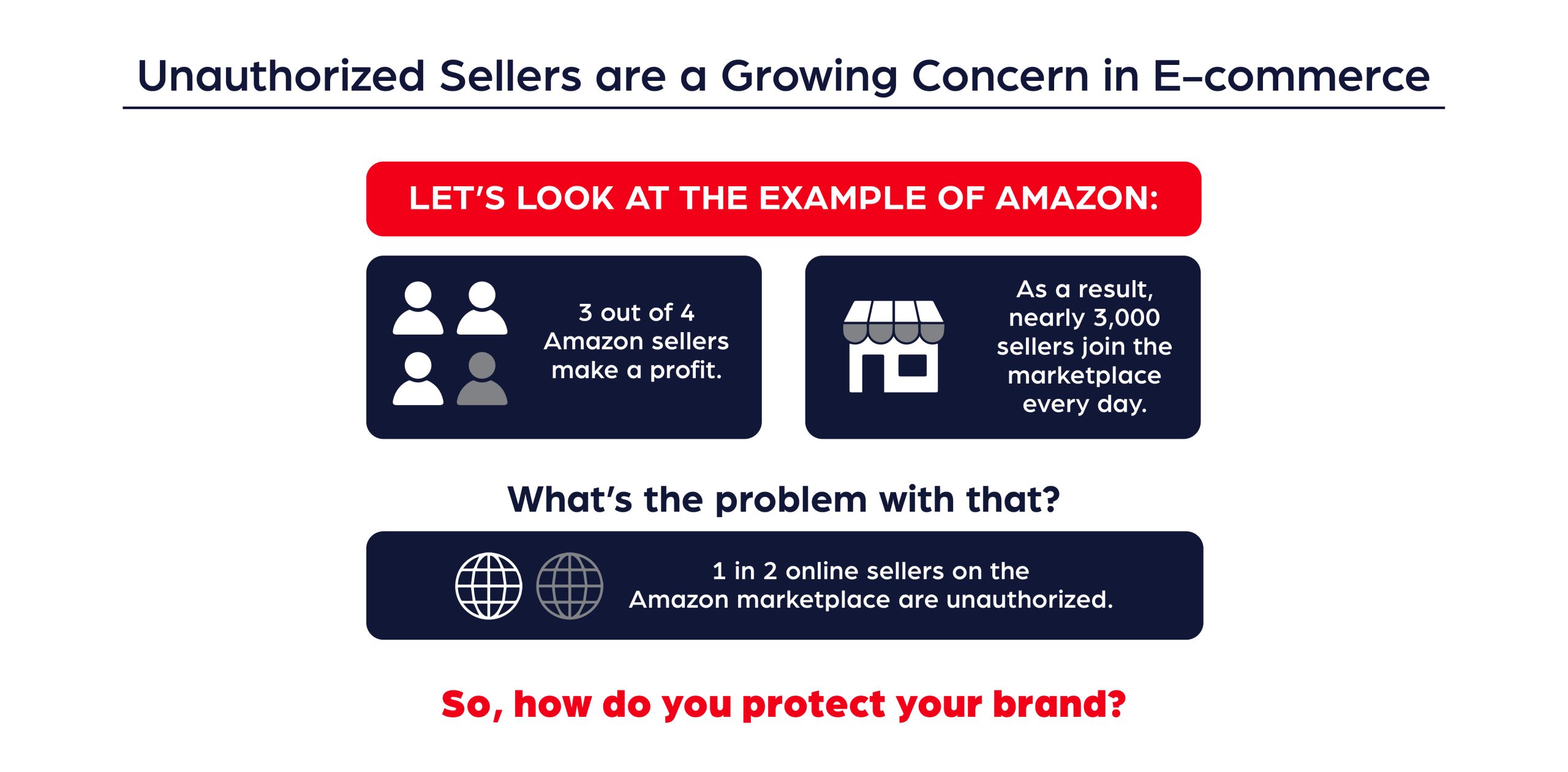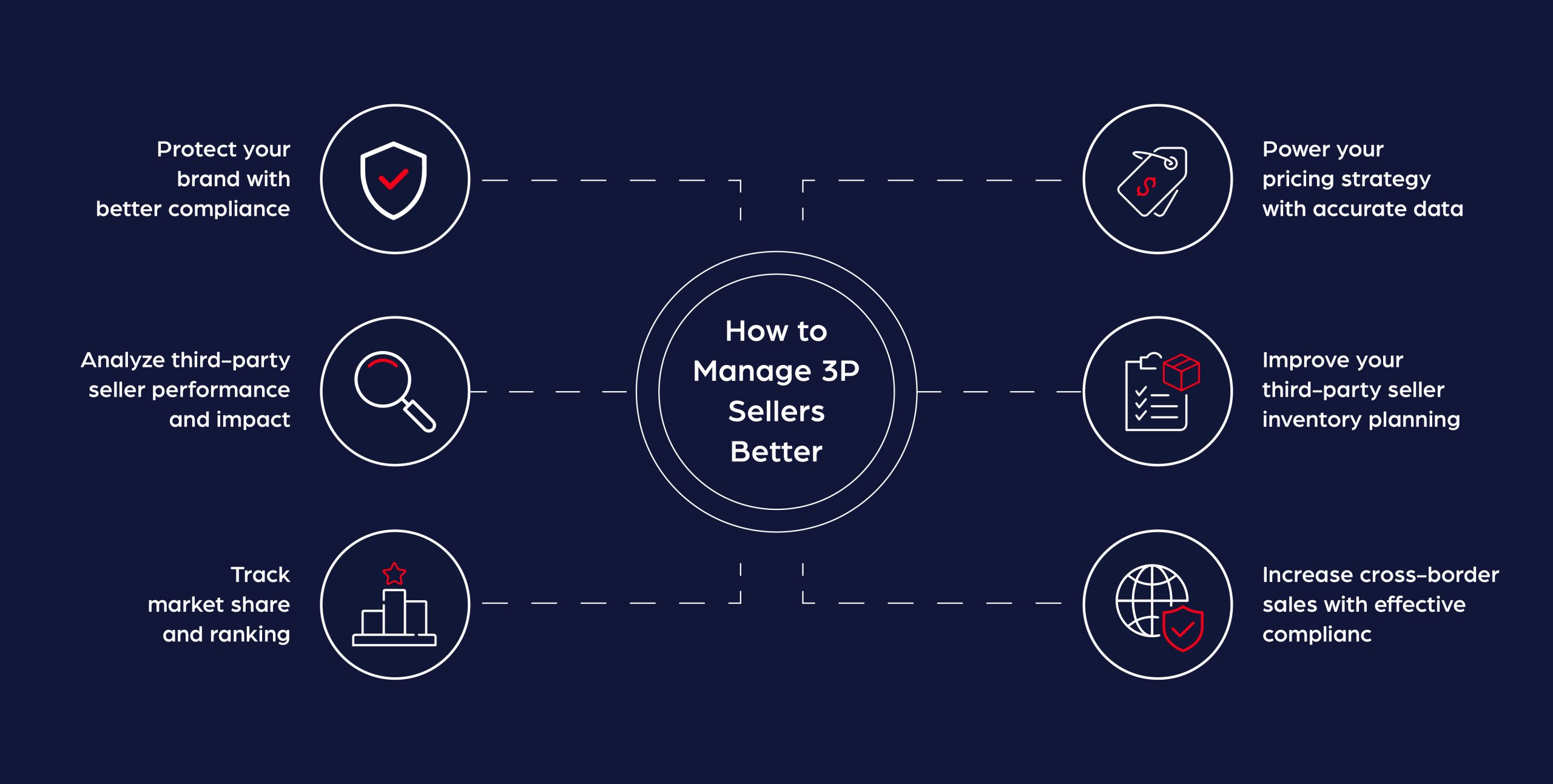
1. Introduction
Have third-party sellers or 3P sellers taken over online retail?
According to statistics, they certainly have!
Globally, there are a total of 9.5 million Amazon sellers[1], and a majority of them are third-party sellers. In fact, almost 70% of the products on Amazon[2] are sold by these sellers. A similar trend can be seen across several other online sales channels.
Given their popularity on marketplaces, third-party sellers are an integral part of brand e-commerce. Many leading brands in the digital market push their products to consumers via third-party sellers. Collaborating with these sellers allows brands to conveniently reach consumers across different geographies and income levels.

Source: Statista[3]
However, controlling these sellers is a complication every brand struggles with.
2. How Limited Network Visibility makes Third-Party Seller Management Tough
Third-party sellers, both authorized and unauthorized, can significantly impact a brand’s perception on marketplaces. This makes monitoring their efforts a crucial part of your brand’s sales strategy. But the visibility of their efforts is often low. Here are some repercussions you may be experiencing due to limited visibility of your distribution partner activities in online retail:

a. Fall in market share
When third-party sellers offer products or services that do not meet your brand’s established quality or image standards, it can dilute your reputation. Consumers may begin to associate your brand with inconsistency, unreliability, or lower quality, which can deter them from making future purchases as they may lose trust in your brand.
Similarly, grey sellers or unauthorized sellers may not adhere to your brand’s quality control standards and offer counterfeit or subpar products. When consumers unknowingly purchase such products, they may experience issues like poor quality, dysfunctionality, or lack of warranties. These negative experiences can damage your brand’s image and reputation, leading to a loss of market share.
b. Channel conflict
Inefficient monitoring and control over your distribution network can cause channel conflict and inconsistent brand representation. For instance, if different retailers or distributors are selling the same products at varying prices or with differing levels of service, it can lead to confusion among consumers and frustration among channel partners.
c. Poor ranking on marketplaces
Ineffective product listings across your distribution network can decrease your product’s market visibility (or cause poor product discovery) and an overall reduction in your brand’s competitiveness. Competing brands with well-optimized and accurate product listings are more likely to attract customers and repeat sales. This will lead to a decline in your sales and market position.
d. Strategizing without data
Without a comprehensive view of top and underperforming third-party sellers and products, your brand will allocate resources ineffectively. This can lead to the poor allocation of stock, marketing efforts, discounts, and promotional activities. As a result, resources may be used on underperforming products and sellers, while top-performing ones do not receive the attention they deserve. This can affect sales and profitability.
e. Inability to tap into new markets
Ineffective online third-party seller management can hinder new market and cross-border growth. That’s because, without visibility, you cannot assess existing distribution networks, potential competition, and new market dynamics. As a result, adapting your business and seizing opportunities becomes a challenge.
f. Ineffective sales strategies
Manual and dependent reporting structures prevent you from getting real-time data on distributor performance across sales channels. The absence of recent sales updates will leave you unsure of your distribution partner’s success in different markets. As a result, you won’t know if the partnership is fruitful.
A lack of performance insights will also force your brand to rely on outdated or incomplete information for critical decisions. This can lead to suboptimal strategies, such as overstocking or understocking, which can result in lost sales and negatively affect the brand’s image.
g. Price violations
Unethical pricing practices by third-party sellers and grey sellers undercut your brand’s pricing guidelines and create confusion among consumers. When customers see the same product offered at different prices, they may wonder about the product’s true value and legitimacy. Similarly, if customers can find the same items at lower prices through unauthorized sellers, they may begin to associate the brand with higher costs and question whether the premium rates are justified.
3. Brand Protection Solutions – The Need of the Hour
Nearly 3 out of 4 Amazon sellers (73%)[4] report profit margins above 10%, and more than a third (35%) exceed 20%. This statistic is interesting because it proves why nearly 3,000 sellers[5] eagerly join the marketplace every day.
Including unauthorized sellers!

[Source – 4,5,6]
Last year, Amazon stopped over 800,000 attempts[6] to create new seller accounts, preventing bad sellers from joining their platforms. In the same year, the marketplace identified, seized, and appropriately disposed of over 6 million counterfeit products.However, some statistics suggest that 1 in 2 online sellers on the Amazon marketplace are unauthorized. And, these businesses are a real cause for concern as they damage your distribution network and customer perception.
To aid you in your efforts to discover grey sellers, it’s essential to implement brand protection solutions like grey seller and third-party seller management. A vital element powering these solutions is AI-driven insights that help detect price violations, track 3P sales performance, pricing history, and identify best and worst sellers.
4. Essential Capabilities to Survive Third-Party Seller Management in E-commerce
When choosing a brand protection solution for third-party and grey seller management, ensure it is powered by advanced Digital Shelf Analytics and has the capabilities to:

a. Protect your brand with better compliance
Invest in a solution that can track the third-party seller presence of your brand on different sales channels. Ensure that the insights you receive are easy to understand and act upon so you know how your partners are performing and can monitor their online activities. This solution should identify online grey sellers so you can flag them and optimize your sales strategies. It should help you maintain product listing accuracy and eliminate product dupes by tracking third-party seller SKUs. At the same time, the updates that you receive should offer high-level insights on sales, pricing, inventory availability, and bottlenecks in operations.
b. Power your pricing strategy with accurate data
Collect rich insights on discounts offered, price variations, and product performance to identify how your third-party sellers are pricing your products. Take note of pricing discrepancies, competitive pricing strategies, and where your third-party sellers stand in the market. Understand how unauthorized sellers are hurting your brand and revenue through unethical practices. Utilize this data to estimate potential revenue growth and losses and protect your product pricing.
c. Analyze third-party seller performance and impacts
Stay on top of sales volume and revenue generated by individual third-party sellers so you can segregate your best and worst sales partners. Use critical market insights by comparing and analyzing the GMV of all sellers across different timeframes to note if there are improvements in their performance after strategy tweaks. You can also use this information to calculate revenue loss and determine the impact of grey sellers on your sales and brand reputation.

d. Improve your third-party seller inventory planning
To stay on top of product availability and replenish third-party inventory on time, you need to know their stock levels. Track and analyze inventory including out-of-stock, available-to-purchase products, as well as newly launched products by your third-party seller. Compare this with the sales report you receive and optimize your inventory palling based on sales velocity and stock availability. This will help minimize stockouts, and overstocking, and ensure your supply chain management is at its best.
e. Track market share and ranking
Tracking market share involves regularly assessing and calculating your brand’s portion of the market’s economic activity. Market ranking refers to your brand’s position in comparison to competitors within a specific market or industry. This ranking can be based on various factors, such as market share, revenue, customer satisfaction, or other relevant metrics. To get a hold of your digital market, you need a consolidated picture of your market share with your official stores and authorized sellers to compare it with a competitor to see where you stand.
f. Increase cross-border sales with effective compliance
Implementing uniform standards for distribution will minimize the oversight of your third-party distributor. With a consistent appearance across sales channels, your brand can build a stable presence in the market.
Additionally, uniform distribution standards also minimize risks associated with cross-border businesses by maintaining oversight over third-party sellers. These standards also ensure a cohesive brand image and customer experience across all your distribution channels.
5. Conclusion
When it comes to third-party online sellers, you can’t control what you can’t see. That’s why you need visibility through better data.
Visibility is vital for your brand to monitor third-party distribution networks and protect against third-party seller violations. But as the e-commerce market continues to grow, obtaining visibility becomes complex. Fortunately, brand protection solutions for gery seller and third-party seller management can help you see your partners’ performance and impacts on your business.
With the right solution, you can analyze and compare your partner’s distribution efforts and enforce compliance. Good compliance by third-party sellers will boost profit margins. Similarly, it will enable you to identify unauthorized sellers and gauge the revenue lost to them.
Investment in digital shelf analytics is already on the rise. And as the technology powering these solutions continues to develop, your control over third-party sellers will improve considerably. Moreover, you will have the means to curb unauthorized sellers that pose a threat to your business.
Are you ready to seize control of your online distribution network in real-time? Reach out to the e-commerce experts at Anchanto and learn all about our latest e-commerce solutions for your brand.
